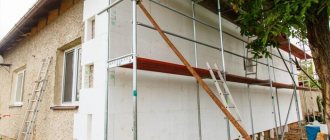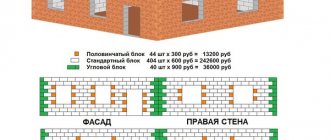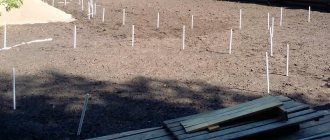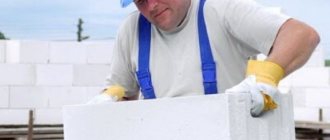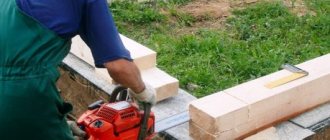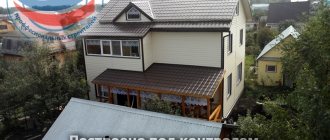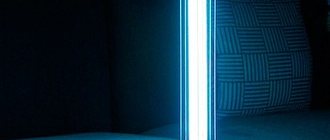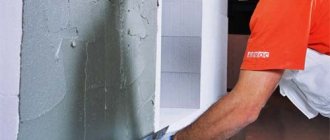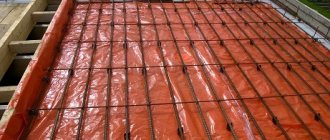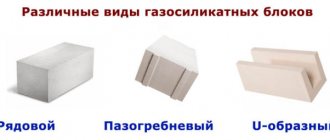What influences construction?
Materials for building a house must be selected in advance and very carefully. There are no perfect building blocks. All of them have both advantages and relative disadvantages. The choice should be made so that the “cons” are compensated.
Construction is directly affected by external conditions. Houses are built in different climatic conditions and soil characteristics.
Houses made from building blocks are built faster than conventional ones. Quality may vary depending on several factors:
- The course of groundwater,
- Type of foundation and its stability,
- Required construction speed,
- Complexity of exterior decoration, etc.
First of all, you need to decide whether the house will have a basement or a basement. If groundwater is too close, expensive foundation waterproofing and drainage may be required.
Before construction begins, the type of foundation is determined. Some types of blocks do not tolerate movement. This affects the stability of the foundation. The cost will increase if the walls need to be erected in an extremely short time.
Please note that not all building blocks can withstand getting wet. They must be protected from precipitation during the construction process. Walls can be vapor-tight. You can make thermal insulation, which will reduce heating costs.
Without the listed nuances, it is impossible to begin full-fledged construction. All these points need to be discussed in advance.
What types of tongue-and-groove blocks are there?
The growing demand for tongue-and-groove blocks is due to the low weight of the elements. Gypsum is added to the composition, which does not affect the operational and technical parameters.
Main characteristics:
- low weight;
- high-quality sound insulation;
- low thermal conductivity;
- corrosion resistance;
- correct shape and size;
- ease of installation.
Modern gypsum tongue-and-groove slabs, depending on the degree of moisture absorption, are divided into ordinary and moisture-resistant.
Due to the clean, smooth surface and ideal appearance, finishing of tongue-and-groove elements is not required.
Intended for interior work, usually produced using 2 methods:
- standard. It has a pure, white color;
- moisture resistant. Made with green color.
The dimensions of the blocks are fixed: 66.7x50x8 cm. A standard pallet can accommodate 30 elements at a time, each weighing up to 29 kg. The volume of the pallet with blocks is 0.8 m3. From one pallet it is possible to build a partition with an area of 10 m2.
Types of building blocks
Creating rooms from building blocks does not require much time. Brick construction takes much longer.
The building blocks are:
- Lightweight concrete sections,
- Foam concrete,
- Expanded clay block,
- Aerated concrete,
- Polystyrene concrete,
- cinder block,
- Porous ceramics or ceramic block,
- Pressed cement-sand blocks.
Types of reinforced concrete wall blocks
The following products are produced from concrete reinforced with steel rods:
- foundation elements (FBS);
- products with cutouts for laying utility networks (FBV);
- hollow building material (FBP).
Depending on the brand of reinforced concrete products, the dimensions are:
- length – 0.88–2.38 m;
- width – 0.3–0.6 m;
- height – 0.28–0.58 m.
The products are characterized by increased strength, but have low thermal insulation characteristics. Advantages of reinforced concrete:
One of the types of building blocks are reinforced concrete
- saving mortar when laying;
- increased strength;
- high noise absorption;
- resistance to moisture;
- resistance to temperature fluctuations.
The disadvantages include the significant weight and increased cost of block reinforced concrete. The increased dimensions and weight do not allow the use of standard pallets for transportation. Products with the abbreviation FBS, FBV and FBP are protected from damage during transportation by road using wooden planks 3 cm thick.
Aerated concrete blocks: pros and cons
Aerated concrete is a cement-sand mixture that contains dry foam-forming reagents. When water is added, the reagents react with the laitance and foam begins to form. The material increases in volume, the solution is laid out in special forms and is expected to be completely ready.
Aerated concrete is a material consisting of thin concrete shells with air inside. The blocks are warm and light, they do not let in steam and moisture. When building with aerated concrete blocks, you should not delay waterproofing the foundation and finishing.
A standard aerated concrete block is 600 mm long, 200 mm high, and 150 to 400 mm wide. Weight varies slightly depending on the manufacturer. When producing blocks of this type, one of two technologies can be used.
First technology: the solution is put into molds and then used. The second technology: large blocks are made and cut into small ones. The principle of the second technology is that it is possible to achieve maximum accuracy. You can use special glue rather than masonry mortar made of sand and cement. It is laid in a thin layer of a few millimeters. Thanks to thin, neat seams, heat loss is reduced. But glue is an expensive product, so the total cost of construction increases. At the same time, there are savings on insulation.
Advantages of aerated concrete:
- Ease of processing,
- Achieving the required dimensions,
- Vapor conductivity,
- Fire resistance
- Environmental Safety,
- Ability to work with a hacksaw.
Disadvantages of aerated concrete:
- The high cost of glue, which increases the cost of construction,
- The need for reinforcement
- Requires exterior finishing and foundation waterproofing,
- Intolerance to bending loads,
- Cannot be installed in areas with seismic activity.
Aerated concrete is easy to work with; it can be cut with a saw or created grooves using a metal strip. The material is not too dense, so you should not hang heavy objects on the walls without special fasteners.
Let's note some shortcomings. Aerated concrete blocks are quite fragile; they do not withstand bending loads very well. It is better not to make a house from aerated concrete blocks on a columnar or pile foundation. You can use deep tape or slabs.
Another feature: to increase the strength of the walls, you need to lay steel reinforcement in the third or fourth row. Reinforcement of window and door openings is also necessary. The armored belt is also used for roof installation. All these procedures make construction more expensive. Costs for fittings are included in the estimate without fail.
What are the types of blocks for construction from expanded clay concrete?
Expanded clay blocks are produced by vibration compaction of concrete poured into special molds. The demand for this promising material is due to the use of environmentally friendly baked clay granules, which give the concrete a porous structure.
Blocks made from sand, cement and expanded clay have strength indicators equal to sand-cement elements, but are significantly inferior to them in mass
The basis of expanded clay blocks is ecological raw materials:
- Portland cement;
- sand;
- water;
- expanded clay
Solid and hollow products are manufactured in accordance with the requirements of the standard regulating the following dimensions:
- length
– 120–450 mm; - width
– 70–495 mm; - height
– 190 and 240 mm.
The scope of application varies depending on the size:
- the construction of walls is carried out mainly with material with dimensions of 39x19x18.5 cm;
- The construction of partitions is carried out using expanded clay blocks measuring 39x19x9 cm.
With a specific gravity of 0.4–1.8 t/m³, the weight is 10–20 kg. The material is characterized
:
- high sound insulation coefficient;
- light weight;
- increased strength;
- no shrinkage;
- simplicity of masonry;
- resistance to temperature fluctuations;
- resistance to aggressive factors.
In many ways, the characteristics of the material depend on the ratio of the proportions of the components used in production
Disadvantages include
:
- increased fragility;
- increased acquisition costs.
The number of expanded clay blocks on a wooden pallet is determined by a number of factors:
- dimensions of the wooden base;
- size of products.
The maximum number of products on a pallet is:
- 105 pieces for wall products with dimensions 39x19x18.5 cm;
- 120 pieces for partition products measuring 39x19x12 cm;
- 168 pieces for partitions with dimensions 39x19x9 cm.
In this case, the total volume of products in the package is 1–1.5 m³.
What types of gas blocks are there?
Blocks of this type can be conventional or autoclave cured. To build external walls, it is optimal to choose autoclave blocks, since their characteristics are more stable. Their cost is more expensive than usual.
Often, a certain amount of cement in aerated concrete is replaced with another material, for example, silicate concrete is made from lime and cement, and slag-gas concrete is made from ground blast furnace slag and cement. Cement with lime and ash creates a material such as ash concrete.
If we talk about the construction of houses with permanent residence, then it is best to use silicate concrete blocks. The material differs from standard aerated concrete in its color. Aerated concrete is gray in color, while silicate concrete is white. The addition of lime reduces the cost with a slight deterioration in properties. But it is worth remembering that lime will corrode steel over time.
Arbolit
Wood concrete or, less commonly, wood concrete is a building material made from cement with crushed wood chips. Despite the fact that it is classified as a lightweight concrete, wood concrete is used only as a heat insulator. Its load-bearing capacity is too low to build load-bearing structures from it. At the same time, the material is very effective as insulation, although, when compared with traditional materials, it loses in weight and other parameters.
The advantages of wood concrete include:
- light weight, no additional load on supporting structures;
- low thermal conductivity, ability to retain thermal energy;
- simplicity and ease of installation;
- environmental cleanliness and safety, absence of harmful emissions;
- affordable price.
Disadvantages of wood concrete:
- the material is not fire resistant;
- wood concrete does not tolerate contact with moisture well and can rot or collapse;
- the organic components of the material attract rodents and insects.
The disadvantages of wood concrete significantly limit its use. Its characteristics are too weak and inferior to more efficient modern materials.
Foam blocks for the construction of residential buildings
Foam blocks only at first glance resemble aerated concrete. The difference is that ready-made foam is added to the mixture of sand and concrete, rather than a dry type reagent. The mixture is kneaded, placed in molds and left to dry. Foam concrete can be made in almost any conditions. But nothing can be said about the stability of the characteristics. However, the material itself is quite good.
Foam concrete has some of the best thermal characteristics. They are only slightly inferior to aerated concrete. Foam concrete walls are usually thicker. But at the same time the load on the foundation is greater. This means that the dimensions of the foundation and the costs for it increase. There is no definite answer which will be cheaper: using gas blocks or foam blocks.
Aerated concrete has lower thermal conductivity, this is explained by the fact that the walls of the air bubbles are thicker. Aerated concrete is more durable and practical. It should be noted that foam block walls allow screws to be screwed in. Special fasteners hold just perfectly.
Foam blocks
Foam blocks are made from foam concrete, which also belongs to the group of cellular concrete. This material is close in its parameters to aerated concrete, but its production technology is fundamentally different. Here the foam is not a product of a chemical reaction, but is added to the sand-cement mortar as a finished physical substance. The solution particles envelop the foam bubbles, harden and form a building material.
Production is simple and does not require the use of complex equipment. This was the reason for the appearance on the market of a large number of foam blocks, handicrafts produced by unknown craftsmen. They do not comply with GOST standards and cannot be used in the construction of critical structures, load-bearing walls, etc.
The advantages and disadvantages of foam blocks are almost the same as those of gas blocks. Externally they look neat and even. High-quality foam blocks should be gray in color. If they are white, it means that a lot of lime has been added to the solution. This reduces the strength of the material, so it is better not to buy such blocks.
Pros and cons of foam blocks
Foam blocks are durable, but they have a low density. But, since it is quite simple to produce foam blocks, there is a risk of purchasing low-quality handicraft material.
Thermal insulation properties are high. However, the material cannot withstand long-term bending load. It is necessary to create a strong, stable foundation. The characteristics are not uniform because the pore sizes are different. The block has a rough surface, ensuring good adhesion to plaster mixtures. The choice of finish requires a special approach. The material is environmentally friendly.
Large weight for the material is a minus. Due to the large space, an increase in the size of the foundation is required. It is also necessary to attract helpers. But, if we compare a foam block wall and a brick wall, the thickness of the latter will be greater. In any case, foam block is an economical material. It should also be noted that foam blocks are not a very aesthetic material. After construction, exterior finishing is required.
The important advantages of the material include:
- Environmental Safety,
- Non-flammability,
- Good sound insulation.
The material conducts steam, but less than aerated concrete. At the same time, the frost resistance of foam blocks is higher. Foam concrete does not have ideal geometry. The difference in size can be quite large. The masonry is done only with mortar; the seam must be made thicker to compensate for the size difference between the blocks.
Foam blocks can be easily drilled, cut, and grooved with conventional tools. You can use a grinder or even a hand saw. This feature of the material simplifies plumbing and finishing work. Installation of electrical wiring in such a house requires a minimum of time.
In general, we can say that foam block is an inexpensive material that will last for many years if you make the right choice of manufacturer. Walls made of foam blocks are erected very quickly. The house is quiet, warm, you can use self-tapping screws. It is not advisable to leave a box without a roof over the winter. Finishing is required, which can be done some time after the walls are erected.
Foam blocks can be used to build load-bearing walls in buildings up to three floors. In this case, a brand from D900 and higher is used. It is important to check in advance what kind of cement the manufacturer uses in foam blocks. Check certificates and brand strength in advance.
Ceramic block
Ceramic block is a material that is a modification of ordinary brick. It is made from the same source material, aged and fired under approximately the same conditions as ordinary ceramic bricks. Externally they are similar, the difference is the internal structure of the block - it has many through voids located on the working surfaces.
At the same time, externally, in a photo, or by directly examining the wall, it is impossible to accurately determine whether it is a facing brick or a ceramic block. The only difference for an experienced person may be the size - the blocks are slightly larger, which speeds up the laying.
Advantages of ceramic blocks:
- relatively low weight;
- high level of thermal insulation;
- the material has a durable and load-resistant structure;
- sound insulation ability;
- convenient installation (there are connecting elements that fit into each other);
- environmental Safety.
Disadvantages of ceramic blocks:
- walls made of this material do not hold well with conventional fasteners - nails or self-tapping screws;
- transportation is complicated due to the fragility of the hollow blocks;
- when laying it is important to strictly follow the technology;
- high price.
Ceramic blocks appeared relatively recently, so their popularity and demand are yet to come.
Polystyrene concrete blocks
Polystyrene concrete is cement with the addition of polystyrene granules. This improves stackability. The mixture is stirred, water is added and poured into molds. You need to wait until it cools completely. This technology does not imply achieving ideal geometry, however, the material is easy to process.
Polystyrene concrete blocks can be sawed with a regular hand saw. The shape is stable and durable, shrinkage is minimal. The material has a small mass. It is smaller compared to aerated concrete of similar strength.
Polystyrene concrete blocks are quite large, construction proceeds quickly. The material is placed on a regular solution; it is allowed to use glue. It is applied in a thin layer, but adhesives are more expensive. The negative side is standard for lightweight concrete blocks. To increase strength, reinforcement is needed. A number of companies place reinforcement inside the blocks.
The material can also be used to create load-bearing walls. You can purchase lintels for installation above door and window openings. They have fittings inside. Solidity is ensured, the jumpers act as corners.
Polystyrene concrete blocks
The production of polystyrene concrete is standardized in GOST 51263-99. According to the standard, polystyrene concrete building elements made from sand, cement and water always include polystyrene foam granules.
The main areas of application of expanded polystyrene:
- installation of load-bearing walls;
- creation of enclosing, frame buildings;
- insulation of the house.
Polystyrene concrete is used to form the foundation, facade, roof and insulation of the house; the blocks are characterized by good heat transfer and ease of installation. In terms of thermal conductivity, the foam block is similar to polystyrene concrete elements, but is significantly inferior to them in strength. The density of the material ranges from 150-600 kg/m3.
Most often used for the construction of buildings of any size that require thermal insulation.
Sold as:
- slabs: 60x30x9-20 cm;
- wall blocks: 60x30x20-25 cm;
- elements for partitions: 60x30x8-12 cm.
Building blocks made of polystyrene concrete are lightweight concrete using cement binder and foamed polystyrene as filler.
Positive and negative properties of polystyrene concrete blocks
Let us note the undeniable advantages of this type of material:
- Density, lightness, strength,
- No labor-intensive processing required
- High construction speed,
- Block size,
- Does not support combustion
- Low level of moisture absorption,
- Good sound insulation and thermal conductivity,
- Vapor permeability similar to wood,
- Frost resistance.
Let's note some disadvantages:
- Blocks need to be reinforced, which makes production more expensive and longer,
- Exterior finishing required
- The technology has disadvantages, the characteristics depend on compliance with a number of rules,
- Fasteners are needed if you need to fix objects on the walls,
- There is an artificial component.
Polystyrene concrete has an average level of vapor permeability. The characteristics are similar to those of wood. There is good thermal conductivity.
It is important to note that a structure made from blocks of this type requires cladding. There are not technical, but aesthetic reasons for this. But you can survive several winters without cladding, since frost resistance is at a good level.
When choosing a cladding, you can choose the popular option – the ventilated façade. If you don’t want to use a ventilated façade, you can use plaster, but the usual mixture will not adhere well to cement. The plaster must have polymer additives in its composition. Its consumption is very small, and the walls turn out beautiful and smooth. You don't have to use rough plaster. First, the mesh is stuffed, and then decorative plaster is applied. It is difficult to say how reliable this plaster is, but, nevertheless, it is quite in demand.
Polystyrene blocks are the best choice if you want to build a house at an affordable price and in a short time. However, there is one “but” - you should not have a negative attitude towards polystyrene and you should not be afraid of the need to think about fixing to the walls. It is better to consult with a specialist on how to install doors and windows with polystyrene blocks.
Basic selection criteria
When choosing block building materials, the following points are taken into account:
- environmental friendliness of products and level of fire resistance;
- characteristics of strength and frost resistance;
- thermal conductivity, vapor permeability, sound insulation properties;
- shrinkage, requirements for masonry reinforcement;
- foundation requirements, need for insulation and finishing.
No less important are the scope and cost of both the product itself and installation work.
Expanded clay concrete blocks
Blocks of this type are a well-known and popular material for construction. A mixture of cement and sand is not all the components of the material. Expanded clay is also added, after which everything is mixed and water is added at the final stage. Expanded clay concrete blocks are created using proven standard technology, however, they have their own characteristics. Expanded clay is called baked clay; this material is hygroscopic. To ensure the mass meets the requirements, add more water.
Expanded clay requires a longer mixing of the solution. In production conditions, the problem of the required level of strength can be solved. For example, the solution is processed in an autoclave or vibrocompression is used. If such treatments are not carried out, the material has lower strength properties. The technology for creating blocks is quite simple, so the material is often created in artisanal conditions that do not stand up to criticism. The place of production can be garages and other outbuildings that are not intended for this purpose at all. The blocks are simply made from molds and dried quickly. Note that to achieve strength, expanded clay concrete needs at least 28 days. A separate place is required to store the material. Many “manufacturers” do not know this and immediately sell the created material. Due to the lack of “ripening”, it quickly crumbles and becomes deformed.
Factory material has all the certificates and is more expensive. If you need blocks for the construction of a residential building, you should ask the manufacturer if he has permits. It is dangerous to use handicraft material.
Expanded clay concrete
Expanded clay concrete is a material obtained by mixing ordinary cement mortar with expanded clay. In addition to the basic components, air-entraining additives (AEA) are used.
The material has been produced since the 60s of the last century. Its production technology is simple, but has a lot of fine details, without which it will not be possible to achieve high quality. For example, the order in which the components are mixed is important (sand is added to cement, mixed, water is added and mixed again, after which expanded clay can be added. At this stage, you need to monitor the thickness of the composition - sometimes expanded clay strongly absorbs water, so you need to add it until you get the desired consistency When the material reaches the required viscosity, it is poured into molds and subjected to vibrocompression.
Advantages of expanded clay concrete:
- high strength (there is no limit on the number of storeys of buildings);
- low water absorption;
- the level of thermal conductivity is approximately halfway between brick and aerated concrete;
- high durability;
- the material is not fire hazardous;
- the cost of blocks is relatively low.
Flaws:
- when constructing tall buildings, it is necessary to reinforce the walls;
- The frost resistance of the material is relatively low;
- There are a lot of homemade expanded clay blocks on the market.
The popularity of expanded clay concrete is quite high - it is one of the most commonly used building materials. Expanded clay concrete blocks for building a house are a popular and effective material that allows you to reduce the cost of construction without losing quality and strength.
Pros and cons of expanded clay concrete blocks
The undeniable advantages of blocks of this type include:
- Big sizes,
- Light weight,
- Excellent thermal insulation properties compared to brick.
Solid expanded clay concrete has a lower thermal conductivity than the materials mentioned above. At the same time, expanded clay concrete is much stronger. You can create slotted blocks with it. To build external walls, only expanded clay concrete is used. Thermal insulation is impeccable at all stages of operation of the building. The material has some voids, which reduce its weight and prevent the foundation from being too large and bulky.
Expanded clay concrete walls do not require additional reinforcement. The laying is done quickly and without any problems. The blocks can withstand bending loads very well. There are no too stringent requirements for the foundation. Buildings made from such blocks allow the presence of a columnar or pile foundation.
Expanded clay concrete has some disadvantages. The main thing is high water absorption. In this respect the material is similar to aerated concrete. It is not advisable to do exterior finishing right away. The box should not stand for a long time without a roof. This way it will pick up moisture, and the lifespan of the building will be reduced. It is impossible to achieve perfect geometry, but cement-based plaster can be used. This material fits well and holds securely.
Advantages of expanded clay concrete:
- Light weight but good level of strength,
- Fire resistance
- Simplicity and accessibility of technology,
- Use of natural ingredients,
- Frost resistance is at an average level for the vibration-pressed version, and at a high level for the autoclave version,
- Excellent adhesion to cement-based plaster compositions,
- Good thermal properties.
Disadvantages of the material:
- There are chances of purchasing a low-quality product,
- There are dimensional deviations,
- Low degree of thermal insulation
- External finishing and protection of internal walls from vapors is required.
If you use slotted expanded clay concrete blocks, you will need external insulation. The material is hygroscopic and is not recommended for use as partitions in spaces with high humidity. To build a steam room or make a bathroom partition, it is better to use a different material. To avoid dampness in private housing construction, a vapor barrier can be installed. Humidity control is carried out, including thanks to a high-quality ventilation system.
Before cellular concrete appeared, expanded clay concrete was considered the warmest and lightest material for the construction of residential buildings. Now this material is somewhat inferior to other, more modern materials. It is gradually being forced out of the market by aerated concrete and foam concrete.
Expanded clay concrete blocks are highly environmentally friendly. Only water, cement, sand and expanded clay are used. No artificial ingredients are used. There are also no surfactants, that is, surfactants, which are found in aerated blocks.
Building blocks: types and characteristics
Considering what types of blocks there are for construction, the first criterion for dividing into groups is the nature of the origin of the material:
- artificial. Production is carried out by mixing mixtures. They are convenient due to the possibility of obtaining different sizes, the mixture is poured into the desired shapes, after hardening the blocks are ready for use;
- natural. For production, technologies of polishing natural materials are used, usually based on various types of stone. They are intended for finishing work.
The cheapest type of blocks for construction is artificial, which includes:
- concrete;
- a mixture of expanded clay and concrete;
- blocks with polystyrene and concrete;
- gas silicate;
- foam concrete.
The correct choice of building materials for thermal insulation properties will avoid additional costs for insulation.
Building blocks differ in purpose and are used for:
- laying the foundation;
- erection of walls;
- thermal insulation of the room.
Based on their design, the following types of blocks are distinguished:
- full-bodied. They are integral and do not have voids, which is why they have greater weight and increased strength. They are used to build walls and form foundations. Dimensions of such blocks: width - 30-60 cm, length - 88, 118, 238 cm and height - 28, 58 cm;
- hollow. They are distinguished by the presence of several air pockets; they are less durable, but lightweight and have increased thermal parameters. Dimensions: width – 40-60 cm, length – 238 cm, height – 58 cm;
- smooth. They are used for decorative coatings, as they have a perfectly smooth surface and do not require finishing work;
- corrugated. Manufactured with one or more rough surfaces. They are always used for the construction of load-bearing structures and further processing. The main advantage is better adhesion to plaster.
Modern blocks for construction include various fillers.
Almost all include a certain amount of Portland cement and sand, and additionally add:
Building blocks are a good alternative to other materials for constructing buildings
- clay;
- slaked lime;
- expanded clay granules;
- slags of various origins;
- wood shavings or sawdust;
- inclusions of granite;
- polystyrene crumbs.
When considering what types of blocks there are for building walls, you can get confused if you don’t know the basic selection parameters.
When planning construction, blocks for construction with the following characteristics are selected:
- strength. Indicates the resistance of the material to compressive loads without damage;
- level of thermal conductivity. As the indicator decreases, the amount of heat retained indoors increases;
- frost resistance. The indicator is a reflection of the number of freezing and thawing cycles while maintaining the original structure of the material;
- density. Strength changes depending on the level of density. Denser varieties are highly durable and are used for the construction of walls in highly loaded buildings, but lead to an increase in thermal conductivity;
- water absorption coefficient. Reflects the ability to absorb moisture. Species with a high coefficient require additional cladding.
Building blocks come in different types
Is it worth buying a cinder block?
From the name it is clear that the backfill of slag concrete is slag. As a rule, we are talking about blast furnace slag formed during the smelting of ore. Slag has a porous structure and does not conduct heat well enough.
Cinder blocks were widely used in Soviet times. It was a cheap material for creating various residential buildings. In those years there were practically no fakes, and the material was of good quality. Nowadays, it is important to carefully monitor what you buy. Cinder block production is quite expensive and there are a lot of fakes.
Today there is no slag in cinder blocks. It is replaced by broken glass, crushed stone, expanded clay, broken brick, etc. This is the same waste as slag. But all of the above is not blast furnace slag in the classical sense. The result is a material with unpredictable properties, low thermal conductivity and no guarantee of durability.
If you compare the characteristics of cinder blocks with other modern blocks, they will not impress anyone. Moreover, cinder block has high moisture absorption, 2 times more than foam block and gas block. It becomes extremely clear that cinder block under no circumstances can be called the best option for residential construction. Real blast furnace slag is expensive and difficult to find.
Standard sizes of aerated concrete blocks for the construction of house walls
It is known that blocks of a certain size are used to build walls. Foundation stones also exist separately, but it is not advisable to use them for the construction of walls, since their length makes masonry inconvenient and requires the use of special equipment. To select the parameters of a stone for building walls, they start from its thickness.
For load-bearing external and internal
To begin with, take the density and grade of the stone as a basis. According to GOST and SNiP standards, building block raw materials must provide good thermal insulation and be durable. Therefore, gas blocks of the D500-D900 brand with strength class B2.5 - B3 are often used. The most often used is aerated concrete with a width of 300 mm , which fully satisfies the criteria for the thickness of the supporting structure.
Why this particular size:
- allows you to evenly distribute the load;
- normally holds the load created by the floor slabs;
- meets thermal conductivity requirements;
- allows additional finishing work from the inside and outside.
The most common sizes of aerated concrete stones for load-bearing walls are 600x250x300, as well as 625x250x250. Dimensions are also selected based on the region of construction, because the external walls will be exposed to bad weather during the operation of the house.
So, for the northern regions it is recommended to take stone with a thickness of at least 300 mm, while for southern and eastern cities blocks with a thickness of 250 mm are quite suitable .
You can find out about the standards for the thickness of load-bearing type walls in SNiP 02/23/2003. Here we describe in detail which blocks are best used for the construction of permanent structures in order to maintain thermal conductivity and sound insulation.
What are there for aerated concrete partitions?
Since non-load-bearing partitions do not perform such an important function as main walls, the requirements for them are simpler. The thickness of the aerated block no longer plays a big role here, so if you take too thick a stone there is a risk of “stealing” space in small rooms inside a residential building.
Therefore, the following stones are used for partition walls:
- 625x250x150;
- 625x250x100;
- 600x250x100;
- 600x250x150.
Interior partitions should serve as a sound insulator, so you should still pay attention to the thickness if you don’t want to hear everything that happens in the next room. Partitions are erected from stones with a thickness of no more than 10-15 cm, but the density of the material should not be high. It is enough to choose a stone with a density of D300-D400 .
Such block stones are perfect for constructing partitions; they are also convenient for hiding communications: pipes, wires. They are easy to use and can be easily finished with decorative materials.
Warm porous ceramics or ceramic block
The technology of porous ceramic block is similar to making bricks. The only difference is that the ceramic block “body” is not solid, but consists of jumpers and voids. If we talk about building a house in central Russia, the thickness of the walls made of porous ceramics should be 50 cm.
A similar thickness is required if the house is built from aerated concrete blocks. Additional insulation is not needed here. The walls are single-layer, which is much better than multi-layer. The finishing is made of clinker or facing bricks. The grip here is almost perfect.
Hollow ceramic blocks are one of the best materials, but the disadvantage is the difficulty of installing fasteners.
TYPES OF LIGHT BLOCKS
ARBOLITE (sometimes not quite correctly called sawdust concrete). It is made from sand-cement mixture and wood chips. The material is difficult to ignite and does not support combustion; it can be sawed with a hacksaw, but at the same time it holds fasteners well (unlike aerated concrete).
AERED CONCRETE . The raw materials for its production are fine quartz sand, binders (lime, gypsum, cement) and aluminum powder. When aluminum reacts with an alkaline cement or silicate solution, hydrogen bubbles are formed, due to which the material acquires a cellular structure. The set voluminous monolith is sawed into blocks, which are then dried in an autoclave or electric oven. The technology allows you to vary the density of blocks. Products with a density of 500 kg/m3 or more are considered structural (that is, capable of absorbing force loads).
GAS SILICATE . A type of aerated concrete block made without the use of a cement binder. This is the technology used by leading manufacturers (for example, Ytong). Silicate blocks are somewhat less durable than cement blocks, but have a more uniform structure.
Expanded clay concrete . It is made from sand cement and expanded clay gravel as a filler. There are hollow (double-hollow, four-slit) and solid blocks. The former are cheaper and easier, but the presence of large cavities complicates some construction work, such as chipping. The main disadvantages of expanded clay concrete blocks are their relatively low thermal insulation capacity and instability of geometric dimensions (tolerance up to 5 mm).
CERAMIC P0RIZED BLOCK (otherwise - ceramic porous multi-hollow block). It can be considered the last step in the evolution of red slot brick. The block is also made of fusible clay, but its dimensions are 5-8 times larger, and its voidsity reaches 55%; the voids have the shape of narrow channels, and intensive convective heat exchange does not occur in them, which improves the insulating ability. The ceramic block must be placed only on a plastic mortar that does not fill voids. The material is more difficult to process than cellular concrete, but has significantly greater strength and durability.
FOAM CONCRETE . This cellular block is similar in basic characteristics to aerated concrete, but differs in production technology: synthetic or organic foaming agents are added to the mixture of cement and sand. Foam concrete is superior in strength to gas silicate, but has a less uniform structure.
PERLITE CONCRETE . It uses expanded perlite sand as a filler. The block’s heat-insulating ability is not inferior to aerated concrete, but is much more heat-resistant and durable. The material is produced in Russia in extremely small volumes, and its price is clearly overpriced (from 6 thousand rubles per 1 m3).
POLYSTYRENE CONCRETE . Expanded polystyrene granules occupy more than 50% of its volume. This block is very “warm”, but has low vapor permeability.
CLAG CONCRETE . Today it is produced only in some regions of the Non-Black Earth Region. The material is very cheap, but has low thermal insulation characteristics.
How to reduce heat loss through masonry joints.
To do this, you need to reduce their width as much as possible and/or use “warm” solutions. If the dimensional deviations of the blocks do not exceed 1 mm, then an experienced mason will place them on a layer of mortar no more than 3 mm thick, and then heat loss through the seams can be neglected. Alas, only fairly expensive gas silicate blocks manufactured at enterprises with modern autoclaves and sawing lines (for example, Ytong brand products) have a stable geometry.
When building from porous ceramic, arbolig, expanded clay concrete and foam concrete blocks, the thickness of the joints is usually 10-15 mm, so it is advisable to carry out the masonry using a “warm” mortar. It can be prepared on site from cement and a low-density filler such as perlite sand, which is sold in bags and in bulk.
A ready-made “warm” mixture (Porotherm TM, Knauf LM21, etc.) will cost 2-2.5 times more than one prepared independently (from 300 rubles per 20 kg), however, when building a house with a small area (up to 150 mg), savings are unlikely will justify itself, especially since special adhesives contain plasticizers and retarders, which ensure good adhesion of the solution to the block.
Pros and cons of ceramic blocks
The advantages include good thermal properties and lightness. However, ceramic blocks are a fragile material. Thin partitions can break easily. About 10% of products spoil during transportation. The use of special fasteners is required.
Ceramic blocks have the following positive characteristics:
- High strength.
- Good sound insulation and heat absorption.
- The presence of a corrugated surface that increases thermal resistance,
- Average level of frost resistance,
- Vapor conductivity,
- Average water absorption.
The disadvantages of the material include:
- The need to use special equipment for cutting blocks,
- Errors in geometry
- High price of polished products with stable dimensions,
- Small block size, which makes construction longer,
- The need for special fasteners
- Fragility of the material.
Despite the shortcomings, this material is natural. Its sound insulation characteristics are up to 55 dB, which is a pretty good indicator. In addition, it is worth noting the heat capacity. This indicator demonstrates how much heat a given material can accumulate. It receives heat and releases it in the same volume. If we consider houses for permanent residence, then materials that have a high heat capacity should be used. Ceramic blocks meet this requirement. Walls made of these materials act as heat accumulators.
Currently, the price of 1 cubic meter of ceramic block and the price of autoclaved aerated concrete are almost the same. Aerated concrete blocks are often even a little more expensive. But they require a lot of glue, time and general expense. Ceramics allows you to build without armored belts. Sanded ceramic blocks are laid with a small amount of glue. Ceramics is a reliable material that is familiar to all builders. If you choose this material, you will not regret it.
Porous ceramics have universal characteristics. But some blocks may have cracks. In any case, this does not contradict GOST. If many cracks are found, you can contact the manufacturer, they will replace the blocks.
Ceramic block is a type of brick. According to current rules, small cracks are allowed in bricks if they do not affect the strength. The quality of the masonry is not affected by the presence of non-through cracks. However, if there is a crack in the edge of the ceramic block, then the material loses its former strength. If the edge is torn, the product diverges and the block ceases to be solid and reliable. It is unacceptable to use such blocks in masonry, however, they may not be recognized as defective.
What are the building blocks for walls based on gas silicate?
Block gas silicate is a type of construction product made from porous concrete. The basis of gas silicate, intended for the construction of capital walls and the construction of internal partitions, are the following components:
- Portland cement;
- lime;
- quartz sand;
- water.
The products are produced using the autoclave method, which involves hardening in special vessels under the influence of elevated temperature and steam.
Aerated concrete blocks are produced in industrial conditions using special autoclaves at a certain temperature and pressure
Features are:
- increased strength;
- environmental cleanliness;
- durability;
- affordable price;
- small weight;
- ease of masonry;
- level of thermal insulation.
The disadvantages of the material include:
- increased hygroscopicity;
- the need for external finishing.
The pallet can accommodate up to 50 units of gas silicate products with a total volume of no more than 1.8 m³.
Besser blocks or cement pressed blocks
Sand concrete is another popular type of building blocks. They make both solid and hollow versions of blocks. A wall made of this material is almost monolithic, it is difficult to damage or break through it. High load-bearing capacity is noted. To retain heat, the building must have thick walls, and this increases the cost of the foundation.
It is better to use combined construction. In this case, the walls are laid from a hollow and solid vibro-pressed block. The inner layer has voids, and the outer layer is solid. The strength of the walls and load-bearing capacity are constantly high, as are the thermal properties. It should be noted that this technology makes it possible to make the side of the block “front”. This side has a smooth surface or looks like a “ragged stone”.
Pressed cement blocks are distinguished by the fact that dyes can be added to them. As a result, everything looks unusual and beautiful. In terms of cost, blocks with a “front” side will be slightly more expensive than regular ones. The technology remains unchanged. What building blocks should I choose for my home? The owner decides this on his own. But, if he wants strong and reliable walls, then he should stop at vibro-pressed blocks.
Creating blocks of this type is quite simple. The mixture of sand and cement is first diluted with water. Next, the solution is poured into molds, which are subsequently processed using special vibration-pressing equipment. At the same time, the solution is subjected to pressure and vibration.
In this way, maximum strength is achieved. The walls are fairly light in weight and have good thermal performance. In the USA, this technology has been used for a very long time. Economy-class houses are made from building blocks of this type.
↑ Concrete blocks: functionality, area of use
Of the building blocks, this material appeared first. It was used in places where special strength was required. For example, as a foundation. The use of concrete blocks significantly reduces the construction time of the foundation and reduces its cost.
The dimensions of the concrete block are strictly regulated by state standards. Exact dimensions allow you to calculate the amount of material needed for any building.
Concrete blocks are divided into groups: FBS (solid foundation blocks), FBV (foundation blocks with cutouts) and FBP (hollow foundation blocks). They differ in the brand of concrete that was used in production.
Concrete blocks are made from lightweight concrete. The building material is light in weight. This quality is achieved either by using low-mass aggregate or by foaming cement. Foamed cement is filled with air, which makes it porous when cured. Lightweight concrete blocks have good sound insulation and thermal conductivity.
Pros and cons of vibrocompressed blocks
The main advantage of the technology is the simultaneous pressure and vibration used to process the material. The blocks are homogeneous and durable. There is no heterogeneity, large voids, the walls are smooth and even. Dimensions can be set with great accuracy. Vibration-pressed blocks have better geometry compared to others.
The frost resistance of these blocks is quite high - from 50 cycles, strength from M100 or more. The thermal conductivity level of hollow blocks is from 0.9 W/m²C. This is much lower than needed. Due to this feature, it is necessary to either additionally insulate the walls or make them thicker. Moisture absorption occurs in small volumes, there is no excessive wetting. There is no reliable information about the thermal conductivity of solid blocks. But the level of thermal conductivity is in any case small.
Reinforcement is a mandatory procedure when using hollow vibratory blocks. When constructing walls, you can use both horizontal and vertical reinforcement. If we focus on vertical reinforcement, then it is necessary to use rods that are connected to outlets from the foundation. Horizontal reinforcement means the use of metal mesh. This is how high-strength walls are obtained.
Notable disadvantages include the rather large weight, but small size of the block compared to a block made of lightweight concrete. Vibrocompressed blocks require a strong foundation, which means that construction will be more expensive.
The prices are quite affordable and moderate. The vibrating table is not very expensive equipment, so the cost of the material remains affordable. Vibration-pressed blocks are a completely universal option for the construction of houses with permanent residence. But, despite all the advantages, such houses are not built too often. Such blocks are usually used to build fences. They can serve as facing stone.
Production of foam concrete and aerated concrete blocks
In composition, these two materials differ little from each other, but in the production method they differ significantly. If a foaming agent is used to form cellular pores with a closed structure for foam concrete, then aerated concrete blocks are obtained as a result of a chemical reaction, thanks to aluminum paste (or powder). As a result of the reaction occurring between the catalyst and lime, a porous structure of the product is formed, which has an open shape.
The production of aerated concrete is carried out in two ways: autoclave and non-autoclave, with a natural process of drying the products.
Foam concrete is of non-autoclave origin. Externally, one material can be distinguished from another by color; foam concrete blocks have a grayish tint, and aerated concrete is bright snow-white.
Blocks can be made in two ways:
- pouring the prepared solution into molds of the appropriate size;
- manufacturing a monolith with subsequent cutting of blocks.
Foam concrete, after entering the aerated concrete market, began to lose its position to the latter. One of the main problems of foam concrete products can be considered quite noticeable shrinkage of the material, especially those that have passed through the drying chamber, and high hygroscopicity. In addition, foam concrete is noticeably inferior in terms of thermal insulation characteristics.
About foam concrete blocks, video:
Main characteristics of aerated concrete
The method of manufacturing aerated concrete blocks affects its properties, so the material made by the autoclave method has greater strength, and therefore load-bearing capacity, and products produced by the conventional method have a lower thermal conductivity coefficient.
When choosing aerated concrete blocks, you should definitely pay attention to such a parameter as density, which can be obtained from special alphanumeric markings, for example, D400, D500 or D700 indicates the weight of 1 m3 of the product, but not only, since this indicator is more informative and indicates the scope of use: for load-bearing walls or partitions.
That is, the higher the density, the higher the strength, but also the higher the thermal conductivity coefficient. Aerated blocks with density indicators from D400 to D700 have the optimal combination of all indicators.
Sometimes, especially when building houses for year-round use in a climate zone with harsh winters, the box is built from two layers of material, one of them with a lower density but higher thermal insulation qualities.
If you pay attention to reviews from home owners , you will notice that an attractive point is the possibility of using not only traditional products with standard dimensions, for example, 625x300x250 mm (although blocks with other parameters are available on the market), but also the use of special blocks for lintels, as well as for the installation of floors.
In addition, for partitions it is recommended to use products with a smaller width, which can significantly save usable space.
Features of the construction of houses made of aerated concrete and foam concrete blocks
You can build a house from these materials in the shortest possible time, including with your own hands. This is facilitated by the rather large size of the products and the accuracy of their linear dimensions. You can lay foam blocks and aerated concrete either using regular mortar or using special adhesive compositions.
Until now, therefore, even experts are arguing, citing as arguments, first of all, the cost of one and the second type.
But one thing is obvious: the use of an adhesive composition is more justified, since with this option the thickness of the seams has minimal values, which means that heat loss will also be minimized. And besides this, when building a house from blocks using adhesive mortar, it is easier to adjust the construction at the horizontal and vertical levels, especially considering their almost ideal linear shapes.
Despite the fact that foam concrete and aerated concrete are two different materials, they have common pros and cons , of which you should pay attention to the following:
- sufficiently high vapor permeability of the walls, ensuring the creation of a microclimate in the room favorable for humans;
- satisfactory indicators of thermal conductivity and heat capacity;
- sufficient load-bearing capacity allowing the construction of buildings up to 12-15 m in height;
- fire resistance;
- environmental safety, as they are made from natural raw materials;
- durability, on average the service life of a house made of foam concrete is 40-50 years, and buildings made of aerated concrete – up to 80 years;
- frost resistance is 25-50 cycles, while autoclaved aerated concrete exceeds this period and has indicators equal to 50-100 cycles.
If we consider the “cons”, then, first of all, you should pay attention to:
- the hygroscopicity of these materials, while for aerated concrete the ability to absorb moisture depends on the density: the higher this indicator, the higher the moisture resistance. In order to eliminate this drawback, it is necessary to complete the facade finishing as soon as possible, and it is absolutely undesirable to leave the house “without clothes” for the winter;
- the presence of cold bridges, which significantly reduce the thermal insulation qualities. And if the use of an adhesive composition instead of a traditional solution can eliminate this disadvantage, then the presence of reinforcing belts requires a radical solution, first of all, the installation of an additional heat-insulating layer.
Read more about building a house from aerated concrete here.
